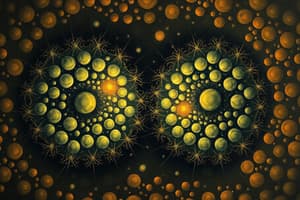Podcast
Questions and Answers
What is the result of Meiosis II in terms of chromosome number?
What is the result of Meiosis II in terms of chromosome number?
- It produces 2 daughter cells with diploid chromosomes.
- It results in a diploid zygote from haploid cells.
- It generates 2 daughter cells with the same number of chromosomes as the parent.
- It separates chromatid pairs resulting in 4 daughter cells with haploid chromosomes. (correct)
What will be the chromosome number of a zygote formed from two haploid gametes?
What will be the chromosome number of a zygote formed from two haploid gametes?
- It will remain haploid (n).
- It will have the same chromosome number as the parents.
- It will be triploid (3n).
- It will be diploid (2n). (correct)
Which of the following is NOT a consequence of abnormal cell division?
Which of the following is NOT a consequence of abnormal cell division?
- Formation of a diploid zygote. (correct)
- Chromosome abnormalities.
- Cancer development.
- Developmental disorders.
In which phase of meiosis are chromatid pairs separated?
In which phase of meiosis are chromatid pairs separated?
What is the chromosome configuration of a diploid parent before meiosis?
What is the chromosome configuration of a diploid parent before meiosis?
What is the primary method of cell division in prokaryotes?
What is the primary method of cell division in prokaryotes?
During which phase of the cell cycle does DNA replication occur?
During which phase of the cell cycle does DNA replication occur?
What occurs during cytokinesis?
What occurs during cytokinesis?
Which phase marks the beginning of mitosis?
Which phase marks the beginning of mitosis?
What is the function of mitosis in eukaryotic cells?
What is the function of mitosis in eukaryotic cells?
Which term describes the time between two successive M phases in the cell cycle?
Which term describes the time between two successive M phases in the cell cycle?
What is a possible outcome of mistakes during DNA replication in binary fission?
What is a possible outcome of mistakes during DNA replication in binary fission?
Which phase of mitosis involves the alignment of chromosomes at the cell's equatorial plane?
Which phase of mitosis involves the alignment of chromosomes at the cell's equatorial plane?
What is the significance of cytokinesis in cell division?
What is the significance of cytokinesis in cell division?
Which phase of mitosis involves the separation of sister chromatids?
Which phase of mitosis involves the separation of sister chromatids?
What is produced as a result of meiosis?
What is produced as a result of meiosis?
How does meiosis I differ from mitosis?
How does meiosis I differ from mitosis?
Which phase of meiosis involves the formation of tetrads?
Which phase of meiosis involves the formation of tetrads?
What is the outcome of meiosis II?
What is the outcome of meiosis II?
Why is meiosis important for sexually reproducing organisms?
Why is meiosis important for sexually reproducing organisms?
What occurs during the metaphase stage of mitosis?
What occurs during the metaphase stage of mitosis?
Flashcards
Meiosis II
Meiosis II
The second division of meiosis that separates chromatid pairs, resulting in four haploid daughter cells.
Gamete Fusion
Gamete Fusion
When two gametes (sex cells) combine to form a zygote, which is always diploid.
Haploid (n)
Haploid (n)
A cell having half the typical number of chromosomes.
Diploid (2n)
Diploid (2n)
Signup and view all the flashcards
Abnormal Cell Division
Abnormal Cell Division
Signup and view all the flashcards
Binary Fission
Binary Fission
Signup and view all the flashcards
Cell Cycle (Eukaryotes)
Cell Cycle (Eukaryotes)
Signup and view all the flashcards
Interphase
Interphase
Signup and view all the flashcards
M phase (Mitosis)
M phase (Mitosis)
Signup and view all the flashcards
Cytokinesis
Cytokinesis
Signup and view all the flashcards
S Phase
S Phase
Signup and view all the flashcards
Daughter cells
Daughter cells
Signup and view all the flashcards
Prokaryotes
Prokaryotes
Signup and view all the flashcards
Cytokinesis (Plant)
Cytokinesis (Plant)
Signup and view all the flashcards
Mitosis Importance
Mitosis Importance
Signup and view all the flashcards
Gametes
Gametes
Signup and view all the flashcards
Genetic Diversity
Genetic Diversity
Signup and view all the flashcards
Chromosome Number Reduction
Chromosome Number Reduction
Signup and view all the flashcards
Study Notes
Cell Division in Prokaryotes: Binary Fission
- Binary fission is a type of asexual reproduction.
- Typically observed in prokaryotes and a few single-celled eukaryotes.
Binary Fission Detailed
- Prokaryotic cells (e.g., bacteria) reproduce through binary fission.
- Asexual reproduction where a parent cell divides to form two identical daughter cells.
- DNA replication occurs at a specific location, proceeds in two directions around the circular DNA molecule.
- Newly synthesized DNA attaches to the inner membrane.
- The cell elongates symmetrically.
- Membrane and wall material grow at the midpoint.
- This continues until the cell completely splits and the daughter cells become separate.
- Occasionally, mistakes in DNA replication can lead to daughter cells which are different.
Cell Division in Eukaryotes: Interphase, Mitosis, and Cytokinesis
- Process where a single cell becomes two identical daughter cells.
- In eukaryotes, mitosis is for growth and repair.
Cell Cycle (Eukaryotes)
- Cell division in eukaryotes proceeds through steps that form the cell cycle.
- Consists of two distinct stages:
- Interphase: time between successive M phases.
- Mitotic (M) phase: the time where the parent cell divides into two daughter cells.
Interphase
- Interphase is the phase of the cell cycle where most typical cells spend most of their life.
- The cell prepares for division during this stage.
- The cell increases in size.
- Sufficient amounts of cytoplasmic and membrane components are received by each daughter cell.
- DNA replication occurs in the nucleus.
Phases of the Cell Cycle
- G₁ phase
- S phase (Synthesis phase)
- G₂ phase
- G₀ phase (cell cycle arrest)
Mitosis Importance
- Essential process for life in multicellular organisms
- Prevents mutations
- Maintains organs
Mitosis Phases
- Prophase
- Prometaphase
- Metaphase
- Anaphase
- Telophase
- Cytokinesis (Animal and Plant)
Prophase
- Chromosomes condense
- Centrosomes radiate microtubules and migrate to opposite poles.
- Nuclear membrane breaks down.
Prometaphase
- Microtubules of the mitotic spindle attach to chromosomes.
- Nuclear membrane starts to break down.
Metaphase
- Chromosomes align in the center of the cell.
Anaphase
- Sister chromatids separate and move to opposite poles of the cell.
- Centromeres split.
Telophase
- Chromosomes reach the poles of the cell.
- The nuclear envelope reforms, and chromosomes decondense.
- Cytoplasm divides, resulting in two daughter cells with identical genetic material.
Cytokinesis (Animal)
- A contractile ring forms to separate the two new cells.
Cytokinesis (Plant)
- A cell plate forms to separate the cytoplasm.
Meiotic Cell Division (Meiosis)
- Cell division in sexually reproducing organisms to produce gametes.
- Results in four genetically unique daughter cells.
- Each daughter cell contains half the number of chromosomes as the parent cell.
- Key importance: genetic diversity
- Essential for reproduction from sexual organisms.
What Does Meiosis Do?
- Produces four daughter cells.
- Each daughter cell has half the number of chromosomes of the parent cell.
- Each daughter cell is genetically unique.
Meiosis Phases
- Meiosis I
- Meiosis II
Meiosis I
- Prophase I
- Metaphase I
- Anaphase I
- Telophase I
Meiosis II
- Prophase II
- Metaphase II
- Anaphase II
- Telophase II
Meiosis I: Prophase I
- Replicated chromosomes condense.
- Synapsis begins.
- Bivalent forms and crossing over occurs.
- Synaptonemal complex dissociates.
Meiosis II
- The nuclear envelope breaks down and chromosomes condense.
- Chromosomes align in the center of the cell.
- Sister chromatids separate.
- The nuclear envelope reforms.
- Cytokinesis occurs.
- Four haploid daughter cells are formed; each one having only one chromosome of each homologous pair.
Abnormal Cell Division (Diseases)
- Cancer
- Chromosome abnormalities
- Developmental disorders
- Neurodegenerative diseases
Studying That Suits You
Use AI to generate personalized quizzes and flashcards to suit your learning preferences.
Related Documents
Description
Explore the mechanisms of cell division, focusing on binary fission in prokaryotes and mitosis in eukaryotes. Learn how these processes contribute to asexual reproduction and cellular growth. Test your understanding of the different stages involved in cell division.




